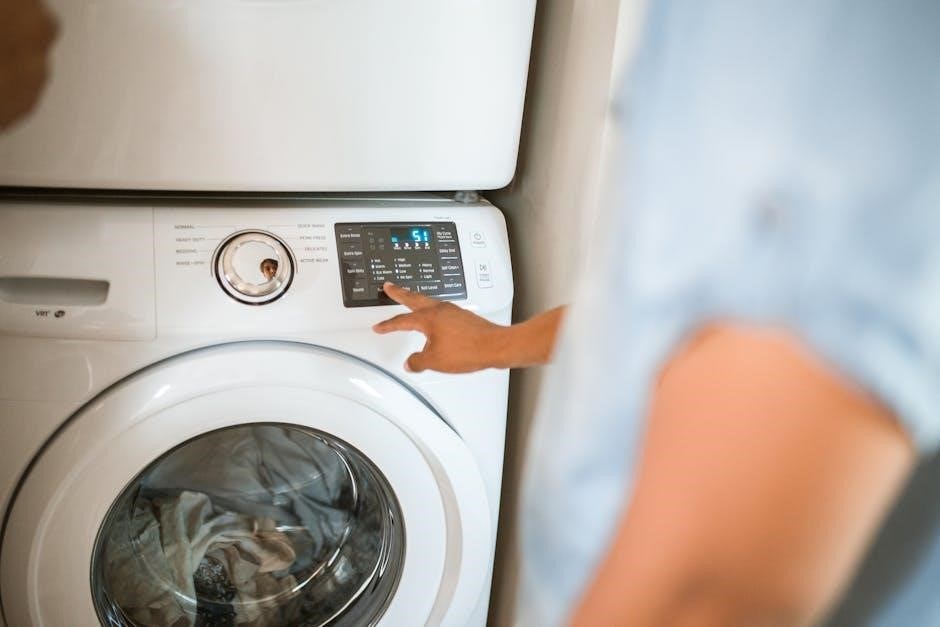KNEX Instructions PDFs provide detailed guides for building various models, from roller coasters to robotics, offering step-by-step diagrams and part lists essential for both beginners and experienced builders.
1.1 What are KNEX Instructions?
KNEX instructions are detailed guides provided in PDF format, designed to help users assemble and create various models using KNEX rods and connectors. These instructions typically include step-by-step diagrams, part lists, and written descriptions to ensure accurate construction. They cover a wide range of models, from simple structures to complex creations like roller coasters and robotic kits. Many instructions are officially released by KNEX, while others are created by the community. The guides often feature visual aids, such as 3D diagrams and symbols, to make the building process easier to follow. Whether you’re a beginner or an experienced builder, KNEX instructions provide a comprehensive roadmap to bring your ideas to life. They are essential for troubleshooting and ensuring that your final model functions as intended.
1.2 Importance of Using Instructions for Building
Using KNEX instructions is crucial for a successful and enjoyable building experience. These guides provide clear, step-by-step directions, ensuring that each model is assembled correctly and functions as intended. Instructions help builders avoid mistakes, such as missing parts or incorrect connections, which can lead to frustration. They also include detailed diagrams and symbols, making it easier to understand complex builds. For beginners, following instructions helps develop essential skills, while experienced builders can use them to refine their techniques. Additionally, many PDFs include safety precautions, battery guidelines, and troubleshooting tips, ensuring a safe and efficient process. By adhering to the instructions, builders can maximize their creativity and achieve professional-looking results. This structured approach makes KNEX instructions indispensable for both learning and mastering various models, regardless of skill level.
1.3 Benefits of PDF Format for Instructions
The PDF format offers numerous advantages for KNEX instructions, making it a preferred choice for builders. PDFs are universally compatible, accessible on any device with a PDF reader, ensuring convenience. They maintain consistent formatting and high-quality visuals, crucial for understanding complex diagrams. PDFs are easily searchable, allowing quick access to specific steps or parts. Portability is another key benefit, as files can be stored on phones or tablets for on-the-go use. Additionally, PDFs are environmentally friendly, reducing the need for physical manuals. They also provide a backup option, preventing loss of instructions. Overall, the PDF format enhances the building experience by combining accessibility, clarity, and practicality, making it an ideal choice for KNEX enthusiasts of all skill levels.

Finding KNEX Instructions Online
Locating KNEX instructions online is straightforward, with resources available on official websites, community forums, and third-party archives, ensuring easy access to guides for various models and sets.
2.1 Official KNEX Websites and Resources
The official KNEX website is the primary source for authentic and reliable instruction manuals in PDF format. These resources are meticulously organized by product model and release year, ensuring users can easily locate the specific guide they need. The official site often features a dedicated support section where visitors can search for instructions by product name, model number, or category. Additionally, KNEX provides downloadable PDFs for both classic and newer sets, making it a one-stop solution for enthusiasts. The official resources are updated regularly, ensuring access to the latest builds and retired models. This centralized platform minimizes the risk of downloading incorrect or incomplete instructions, offering a trusted and user-friendly experience for builders of all skill levels.

2.2 Community-Driven Archives and Forums
Community-driven archives and forums are invaluable resources for locating KNEX instructions in PDF format. Websites like K’NEX Fans or the K’NEX User Group often host extensive libraries of user-contributed manuals, covering both classic and hard-to-find sets. These platforms are maintained by passionate enthusiasts who share their collections, ensuring rare instructions remain accessible. Forums also serve as hubs for discussion, where members can request specific manuals or offer advice on building techniques. Additionally, these communities frequently include custom models and modifications, expanding beyond official instructions. While not officially endorsed, these archives are trusted by many builders and provide a collaborative environment for sharing knowledge and resources. They are particularly useful for those seeking instructions for discontinued or vintage KNEX sets.
2.3 Third-Party Repositories for Rare Sets
Third-party repositories are essential for accessing PDF instructions for rare or discontinued K’NEX sets. Platforms like eBay, Amazon, or specialized forums often host these resources. These repositories are maintained by independent sellers or enthusiasts who digitize and share vintage manuals. While they may not be officially endorsed, they provide a lifeline for builders seeking instructions for out-of-production models. However, users should exercise caution by verifying the authenticity and safety of downloads. These sites often include scans of original booklets, ensuring that even rare sets remain buildable. For collectors or enthusiasts, these repositories are a valuable resource to complete their K’NEX collections. Always check seller ratings or community feedback before downloading to ensure reliability and quality.

Popular KNEX Sets with Available PDF Instructions
Discover iconic K’NEX sets like the Classic Roller Coaster, Robotic Arm, and Amusement Park Series, all offering downloadable PDF guides for easy building. These sets remain fan favorites, blending creativity with precision engineering, and are widely sought after by collectors and enthusiasts. Having access to their instructions ensures timeless enjoyment, even for discontinued models. Explore these beloved kits and bring your ideas to life with step-by-step PDF manuals designed for both beginners and advanced builders. The availability of these guides makes constructing your dream models straightforward and fun. Start your K’NEX journey with these popular sets and unlock endless possibilities. Find inspiration in the detailed diagrams and comprehensive instructions provided. Happy building!
3.1 Classic Roller Coaster Sets
Classic Roller Coaster Sets are among the most beloved K’NEX creations, offering a thrilling building experience. These iconic kits allow enthusiasts to construct intricate roller coasters with loops, hills, and other dynamic features. The availability of PDF instructions ensures that users can easily follow along, even without physical manuals. These guides provide detailed, step-by-step directions, making it easier to bring roller coaster designs to life. With comprehensive diagrams and clear instructions, builders of all skill levels can enjoy the satisfaction of creating their own amusement park attractions. The PDF format also makes it convenient to access instructions across multiple devices, enhancing the building process. Whether you’re a seasoned K’NEX fan or a newcomer, these classic roller coaster sets offer endless hours of creative fun and engineering challenges. They remain a timeless favorite in the K’NEX community.
3.2 Robotics and Motorized Kits
Robotics and Motorized Kits are a fascinating category in the K’NEX universe, offering a blend of creativity and engineering. These kits allow builders to create interactive models like robotic arms, vehicles, and automated systems. The PDF instructions provide detailed step-by-step guides, ensuring that even complex motorized components are easy to assemble. With clear diagrams and explanations, users can understand how to integrate motors, gears, and other mechanical parts seamlessly. These kits are particularly popular among STEM enthusiasts, as they teach fundamental principles of mechanics and automation. The PDF format enables users to zoom in on intricate details, making the building process more manageable. Whether you’re constructing a simple motorized car or a sophisticated robotic figure, these kits offer an engaging way to explore the intersection of creativity and technology. They are a great way to enhance problem-solving skills and foster innovation.
3.3 Educational and STEM-Based Models
Educational and STEM-based K’NEX models are specifically designed to teach fundamental principles of science, technology, engineering, and mathematics; These kits often focus on real-world applications, such as bridges, roller coasters, and simple machines, making learning interactive and engaging. The PDF instructions for these models are tailored to help users understand complex concepts through step-by-step guides. Many STEM-based sets include lesson plans and activities, making them ideal for classroom use. Builders can explore concepts like tension, balance, and motion while constructing models. These kits are particularly beneficial for students, as they foster critical thinking and problem-solving skills. The detailed instructions ensure that learners can grasp key STEM ideas while enjoying the creative process of building. This category is perfect for educators and parents seeking to make learning fun and hands-on.

How to Use KNEX Instructions PDF Effectively
Start by organizing your workspace and ensure all parts are accessible. Use the PDF’s zoom feature to see details clearly. Follow the step-by-step guide methodically, referencing diagrams for visual confirmation. Keep the PDF open on a separate device or print it for easy reference. Regularly review your progress to catch mistakes early.
4.1 Navigating the Instruction Manual
Navigating a KNEX instructions PDF begins with understanding its structure. Typically, manuals are divided into sections, such as a parts list, assembly steps, and diagrams. Start by reviewing the table of contents or index to locate specific sections quickly. Use bookmarks or page references to jump between relevant parts of the guide. Pay attention to page numbering, as some manuals group similar models or variations together. For digital PDFs, utilize search functions to find keywords like “motor” or “track” to locate specific components. Always begin with the introductory pages, which often outline essential tools and safety tips. Familiarize yourself with the visual layout, as most instructions follow a logical, step-by-step progression. This approach ensures a smooth building experience and minimizes confusion.
4.2 Understanding Diagrams and Symbols
Diagrams and symbols in KNEX instructions PDFs are crucial for successful model assembly. Diagrams often replace lengthy written descriptions, providing clear visual guidance. They typically show how parts connect, with arrows indicating assembly directions or which piece fits where. Symbols are universally understood and help avoid language barriers. Common symbols include a checkmark for correct connections and an “X” for incorrect ones. Color coding is also used to differentiate rod lengths or connector types. To interpret these effectively, study the legend or key provided in the manual. Take time to understand each symbol, as they convey essential assembly steps. Familiarity with these visual cues enhances building efficiency and reduces confusion. Always refer back to diagrams when unsure, ensuring accurate and enjoyable assembly experiences.
4.3 Tips for Beginners
For those new to KNEX, starting with smaller models is recommended to build confidence. Begin by sorting pieces by type and size to streamline assembly. Always follow the instructions step-by-step, as skipping steps can lead to errors. Use a flat, stable surface for building to avoid losing parts. If stuck, revisit the diagrams or start over with a simpler section. Don’t hesitate to take breaks to avoid frustration. Joining online communities or forums can provide tips and inspiration. Practice patience, as mastering KNEX takes time. Finally, experiment with leftover pieces to develop creativity and problem-solving skills. These tips will help beginners enjoy a smoother and more rewarding KNEX building experience.

Advanced Building Techniques
Master modular strategies, customize models, and troubleshoot effectively. Explore complex designs, optimize piece usage, and integrate motorized components seamlessly for enhanced creativity and functionality in KNEX builds.
5.1 Modular Building Strategies
Modular building strategies are essential for creating complex and organized KNEX structures. By breaking down your project into smaller, manageable sections, you can focus on one part at a time, ensuring accuracy and stability. Start by identifying key components of your design, such as the base, support structures, and decorative elements. Use rods and connectors to link these modules seamlessly. This approach not only simplifies the building process but also allows for easier troubleshooting; For example, if a section collapses, you can isolate and repair it without dismantling the entire model. Additionally, modular techniques enable reusability, as individual sections can be incorporated into future projects. Plan your modules carefully, considering balance, symmetry, and the flow of forces; This method is particularly effective for large-scale creations like roller coasters or bridges. With practice, modular building becomes second nature, enhancing both efficiency and creativity in your KNEX designs.
5.2 Customizing Models Beyond Instructions
Customizing KNEX models beyond the provided instructions allows builders to express their creativity and personalize their creations. Once familiar with the basic build, enthusiasts can experiment with alternative designs, colors, and features. For instance, adding unique details like intricate patterns or functional elements can make a model stand out. Users can also combine pieces from different sets to create hybrid designs. Modifying the shape or structure of a model can enhance its aesthetic appeal or functionality. Additionally, incorporating custom mechanisms or extending the model’s size can challenge advanced builders. This creative freedom encourages innovation and problem-solving skills. By deviating from the instructions, builders can transform standard models into one-of-a-kind masterpieces, showcasing their individuality and ingenuity. Customization not only enhances the building experience but also fosters a sense of ownership and pride in the final product.
5.3 Troubleshooting Common Issues
Troubleshooting common issues while building with K’NEX can help ensure a smooth and enjoyable experience. One frequent problem is pieces not fitting as expected, often due to incorrect alignment or missing steps in the instructions. To resolve this, carefully re-examine the PDF guide and verify each part’s placement. Another issue is instability in larger models, which can be addressed by adding extra support rods or ensuring proper balance. If a model doesn’t function as intended, such as a roller coaster not moving, check for obstructions or misaligned tracks. Additionally, missing parts can hinder progress, so maintaining an organized workspace is essential. Patience and persistence are key, as some challenges require creative problem-solving. By systematically addressing these common issues, builders can overcome obstacles and successfully complete their K’NEX creations.

Safety and Maintenance
Safety and maintenance are crucial for enjoyable and durable K’NEX building experiences. Proper handling prevents injuries, while regular cleaning and organized storage prolong part longevity.
6.1 Safety Precautions for Building
When working with K’NEX, prioritize safety to avoid accidents. Always handle small parts with care, as they may pose choking hazards for young children. Avoid exposing rods or connectors to excessive force, which can cause sharp edges. Ensure your workspace is clear and well-lit to prevent tripping or misplacing pieces. For motorized models, follow battery installation guidelines and avoid overloading circuits. Never mix damaged or worn-out parts, as they can weaken structures. Keep loose rods and springs away from eyes. Supervise children during builds, especially when using sharp or pointed components. Regularly inspect sets for wear and tear, replacing any damaged elements. By adhering to these precautions, you can enjoy a safe and rewarding building experience with K’NEX.
6.2 Proper Storage of KNEX Parts
Proper storage of K’NEX parts is essential to maintain their condition and ensure they remain organized. Use plastic bins or containers with lids to keep pieces clean and dry. Separate rods, connectors, and other components into labeled sections or smaller pouches for easy access. Store flexible parts like rubber bands and springs in sealed bags to prevent tangling. Keep instruction manuals in a designated folder or with the corresponding set. Avoid mixing old and new parts to preserve their integrity. Clean pieces before storing to remove dirt or grime. Place containers in a cool, dry area away from direct sunlight and moisture. Consider using divider trays or small compartments for small accessories. Regularly check stored items for damage or wear. By organizing and storing K’NEX parts effectively, you can prolong their lifespan and enjoy building for years to come.
6.3 Battery Safety for Motorized Models
Battery safety is crucial for motorized K’NEX models to ensure reliable performance and prevent potential hazards. Always use the battery type specified in the K’NEX instructions PDF to avoid damage or overheating. Avoid overcharging rechargeable batteries, as this can reduce their lifespan or cause leakage. Store batteries in a cool, dry place away from metal objects to prevent accidental discharge. Never mix old and new batteries or different battery types in the same device. If batteries are not in use for an extended period, remove them from the model to prevent leakage. Dispose of batteries properly, following local regulations for hazardous waste. Keep batteries out of reach of children to avoid ingestion. Regularly inspect batteries for signs of wear or corrosion and replace them if necessary. Proper battery safety ensures your motorized K’NEX creations run smoothly and safely for years.

Community and Collaboration
The K’NEX community fosters creativity through shared ideas and collaborations. Enthusiasts exchange custom instructions, inspiring innovation and mutual learning, while collective passion drives the evolution of K’NEX building.
7.1 Sharing Creations and Instructions
Sharing K’NEX creations and instructions fosters a vibrant community of builders. By uploading custom PDF guides, enthusiasts showcase their designs, inspiring others to replicate or adapt them. Online forums and social media platforms serve as hubs for exchanging ideas, with users posting detailed step-by-step manuals. This collaborative environment encourages creativity and innovation, as builders learn from one another’s techniques; Sharing instructions also allows for feedback, helping creators refine their designs. Many fans appreciate the accessibility of these resources, which often include high-quality images and diagrams. Whether it’s a intricate roller coaster or a complex robot, sharing instructions ensures that unique builds are preserved and enjoyed by the broader K’NEX community. This exchange not only strengthens friendships but also fuels the passion for building.
7.2 Participating in KNEX Building Competitions
Participating in K’NEX building competitions is an exciting way to showcase creativity and skill. These events, often hosted by K’NEX communities or enthusiast groups, challenge builders to create innovative models within specific themes or constraints. Competitions can range from local gatherings to online events, making them accessible to a wide audience. Many participants use PDF instructions as a starting point, modifying designs to stand out. Prizes often include K’NEX sets or recognition within the community. Competitions foster healthy competition and encourage builders to push their boundaries. They also provide opportunities to meet fellow enthusiasts and learn new techniques. By engaging in these events, builders gain confidence and refine their skills, making competitions a rewarding experience for K’NEX fans of all ages and skill levels.
7.3 Open-Source KNEX Projects
Open-source K’NEX projects are a vibrant part of the K’NEX community, offering creators the freedom to share and collaborate on innovative designs. These projects are often hosted on platforms like GitHub or community forums, where users can download and modify instructions in PDF format. Open-source initiatives encourage creativity and innovation, allowing builders to adapt and improve upon existing models. Many open-source projects focus on complex or niche designs, such as intricate mechanical devices or scaled replicas. By sharing their work, creators inspire others to experiment and push the boundaries of what K’NEX can achieve. This collaborative approach not only fosters a sense of community but also ensures that unique and imaginative models are preserved and accessible to everyone. Open-source K’NEX projects are a testament to the power of shared knowledge and creativity.

Getting Started with KNEX
Begin with essential tools like rods, connectors, and a flat surface. Start with simple models from the PDF instructions to build confidence and skills. Patience and practice lead to mastery and enjoyment of K’NEX creations.

8.1 Essential Tools for Building
Starting with K’NEX requires basic tools to ensure a smooth building experience. The primary components include rods, connectors, wheels, and motors, which are typically included in K’NEX kits. A flat, stable workspace is crucial for organizing parts and following the PDF instructions. Good lighting helps in identifying small pieces and understanding intricate details. Optional tools like Allen wrenches or small clamps can aid in securing parts, especially for motorized models. A container for sorting and storing rods and connectors can improve efficiency. While no additional tools are necessary, having a well-prepared workspace enhances creativity and focus. Always refer to the K’NEX instructions PDF for specific tool recommendations tailored to your set.
8.2 Setting Up Your Workspace
Setting up an efficient workspace is key to a enjoyable K’NEX building experience. Begin by choosing a flat, stable surface, such as a table or countertop, to prevent pieces from rolling away. Ensure the area is well-lit to easily see small components. Clear any clutter to avoid losing parts and maintain focus. Organize K’NEX rods, connectors, and other elements in separate containers or trays to streamline access. Consider using a white background to make small pieces more visible. Keep the K’NEX instructions PDF open on a second screen or print them for easy reference. Finally, position your tools and supplies within reach to minimize interruptions while building. A well-organized workspace enhances creativity and ensures a smooth assembly process.
8.3 Building Your First Model
Building your first K’NEX model is an exciting step in your creative journey. Start by selecting a simple model from the K’NEX instructions PDF, such as a basic roller or small structure, to ease into the process. Gather all required parts beforehand using the included checklist to avoid missing pieces. Follow the step-by-step guide, focusing on one section at a time to maintain clarity. Use the diagrams to visualize each stage, ensuring proper alignment of rods and connectors. If unsure, refer to the symbol key or real-world images for clarification. Take your time, as patience is key to accuracy. Celebrate small victories as each section comes together, and don’t hesitate to disassemble and retry if needed. Completing your first model builds confidence and sets the foundation for more complex creations. Happy building!
